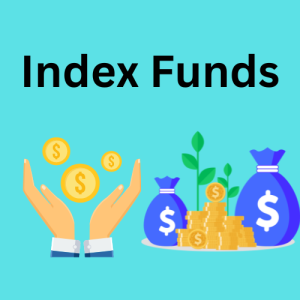An index in finance refers to a statistical measure that tracks the performance of a group of assets, such as stocks, bonds, or other investments, to represent a specific segment of the financial market. Indices are often used as benchmarks to gauge the performance of individual investments or broader market sectors.
What is an Index Fund?

An Index Fund in India is a type of mutual fund that aims to replicate the performance of a specific stock market index by investing in the same securities that make up that index in the same proportions. Like index funds globally, these are passively managed funds, designed to track the performance of major Indian stock market indices, such as the Nifty 50 or Sensex.
How does Index Fund Work?
An Index Fund works by passively replicating the performance of a specific market index, such as the Nifty 50 or Sensex, by holding the same securities in the same proportion as the index. Here’s a step-by-step explanation of how an index fund operates:
1. Mirroring the Index
The primary goal of an index fund is to track the performance of a specific index For example, if you invest in a Nifty 50 index fund, the fund manager will buy the 50 stocks that make up the Nifty 50, in the same proportions as they are in the index. If Reliance Industries represents 10% of the Nifty 50 index, then 10% of the fund’s assets will be invested in Reliance.
2. Passive Management
Passive Management means that the index fund manager does not actively buy and sell securities to outperform the market. Instead, the goal is to *as closely as possible. Since the fund only aims to track the index and not outperform it, there is no need for frequent stock-picking or market timing, which reduces costs and transaction fees.
3. Portfolio Construction
The fund holds all the stocks of the underlying index. For example:
- In a Nifty 50 index fund, the fund will invest in the top 50 companies listed on the National Stock Exchange (NSE).
- In a Sensex index fund, the fund will invest in the 30 largest companies listed on the Bombay Stock Exchange (BSE).
The proportion of each stock in the portfolio is aligned with the weighting of each stock in the index.
4. Tracking the Index
The index fund tracks the performance of the index. If the index increases in value by 10%, the value of the index fund should rise by approximately 10% (minus fees). If the index declines, the index fund will decline similarly. A key factor here is tracking error, which is the difference between the performance of the index fund and the index itself. Good index funds have a low tracking error, meaning their performance very closely mirrors that of the underlying index.
5. Low Costs and Expense Ratios
Since index funds are passively managed, they have lower operating costs than actively managed funds. This results in lower expense ratios (the annual fee charged by the fund).For example, an actively managed mutual fund may charge an expense ratio of around 1-2%, while an index fund might charge only 0.1-0.5%. This difference in fees can significantly impact long-term returns.
6. Automatic Rebalancing
As the composition of the index changes (due to companies entering or exiting the index or changes in the market capitalization of constituent companies), the index fund manager will automatically rebalance the fund’s holdings to match the index. For example, if a company is removed from the Nifty 50, the fund will sell its shares in that company and buy shares in the new company added to the index.
7. Dividends and Income
Many companies in an index pay dividends. An index fund will pass these dividends on to investors. The fund may offer the option to either reinvest the dividends (to buy more units of the fund) or distribute them as cash to investors. The performance of the fund includes both the capital appreciation from stock price increases and the dividend income from the companies in the index.
8. Performance of the Index Fund
The performance of an index fund is directly tied to the performance of the underlying index. If the index performs well, the index fund performs well, and if the index declines, the fund’s value also decreases. For example, if the Nifty 50 index grows at 8% over a year, an index fund tracking the Nifty 50 will also grow by around 8%, minus any fees and expenses.
9. Buying and Selling Index Funds
Investors can buy and sell units of an index fund through a mutual fund company, broker, or online platforms. If it is structured as a mutual fund, you can buy units directly from the fund provider at the current Net Asset Value (NAV). If it’s an Exchange-Traded Fund (ETF), you can trade it on stock exchanges like NSE or BSE, similar to how you buy and sell stocks.
How to invest in Index Funds in India
Investing in index funds in India is simple and can be done through various platforms, including mutual fund houses, stockbrokers, and online investment platforms. Here’s a step-by-step guide on how to invest in index funds:
1. Choose an Index Fund
First, decide which index you want to track. Popular indices in India include:
- Nifty 50: Represents the top 50 companies on the National Stock Exchange (NSE).
- Sensex: Represents the top 30 companies on the Bombay Stock Exchange (BSE).
- Nifty Next 50: Tracks the next 50 largest companies after the Nifty 50.
Look at different mutual fund providers and their index fund offerings. Compare factors like:
- Expense Ratio: Lower is better for long-term returns.
- Tracking Error: The closer the fund mirrors the index, the better.
- Fund Size and History: Larger, older funds tend to be more stable.
2. Select a Platform to Invest Through
You can invest in index funds through various platforms. Some of the common options include:
a) Directly from Mutual Fund Houses
b) Through Online Investment Platforms
c) Banks and Financial Institutions
d) Through Stockbrokers (For ETFs)
3. Complete Your KYC
Before you can invest in mutual funds in India, you need to complete the Know Your Customer (KYC) process. This is mandatory and involves submitting:
- Identity Proof: Aadhaar, PAN card, etc.
- Address Proof: Aadhaar, utility bills, etc.
- Photograph and sometimes bank details.
You can complete your KYC online via platforms like CAMS or KFintech, or directly with fund houses or your bank.
4. Decide Between Lump Sum or SIP Investment
You can invest in index funds in two ways:
- Lump Sum Investment: You invest a one-time large amount. This is useful if you have surplus funds and want to invest them at once.
- Systematic Investment Plan (SIP): You can invest a fixed amount on a regular basis (monthly or quarterly). SIPs help spread investments over time and reduce market timing risks. For example, you might decide to invest ₹5,000 per month in a Nifty 50 index fund via SIP.
5. Place Your Order
- If you’re investing directly with a mutual fund house or through an online platform, log in to your account, select the index fund, and choose how you want to invest (lump sum or SIP).
- For ETFs, you can place a buy order through your stockbroker at the current market price. Unlike mutual funds, ETFs are bought and sold during market hours.
6. Monitor and Track Your Investment
- Although index funds are passive investments, it’s still important to review your portfolio periodically.
- Keep track of the fund’s performance and how well it’s tracking the index.
- Look at the expense ratio and any significant tracking error over time.
7. Stay Invested for the Long Term
- Index funds work best when held for the long term. The longer you stay invested, the more you benefit from compounding and market growth.
- Avoid frequent buying and selling, as index funds are designed for long-term wealth building rather than short-term trading.
Benefits of Investing in Index funds
Investing in index funds offers several benefits, especially for those looking for a simple, cost-effective, and diversified approach to long-term wealth creation. Below are the key advantages:
1. Low Cost
- Expense Ratios for index funds are typically much lower than those for actively managed funds because they don’t require active management or frequent buying and selling of stocks.
- Lower costs translate into higher net returns for investors over time, especially when compounded over the long term.
2. Diversification
- Index funds invest in all the stocks or securities that make up a specific market index, offering broad market exposure in a single investment.
- For example, a Nifty 50 index fund provides exposure to the top 50 companies across various sectors in India, reducing the risk associated with individual stocks or sectors.
3. Simplicity
- Index funds are easy to understand. You are investing in the market as a whole rather than picking individual stocks or relying on a fund manager to outperform the market.
- It’s a passive investment strategy where you simply match the performance of the index, making it ideal for those who want a “set it and forget it” approach.
4. Consistent Market Performance
- Since index funds aim to replicate the market’s performance, they offer returns similar to the market index they track. Historically, the market tends to grow over the long term.
- While an actively managed fund might outperform the market occasionally, index funds consistently follow the broad market’s upward trajectory over time.
5. Reduced Risk of Underperformance
- Unlike actively managed funds, where the fund manager may or may not outperform the market, index funds eliminate the risk of poor manager performance.
- No stock-picking risk: By investing in all the stocks in an index, you avoid the risk of selecting the wrong individual stocks.
6. Low Maintenance
- Index funds require little attention. Since they track a specific index, there’s no need for frequent adjustments or monitoring.
- For long-term investors, this “buy and hold” strategy makes index funds ideal as you don’t have to worry about short-term market fluctuations or active trading.
7. Tax Efficiency
- Index funds tend to generate lower capital gains compared to actively managed funds because there is less turnover of securities. This can result in lower tax liabilities for investors, particularly in the case of long-term capital gains.
- Long-term gains (held for over a year) in equity index funds in India are taxed at 10% only if gains exceed ₹1 lakh.
8. Predictable and Transparent
- Index funds are highly transparent because you know exactly what you’re investing in. The list of securities in the fund is the same as the underlying index, and there are no surprises in terms of sudden stock picks or changes.
- This transparency makes index funds easier to track and understand compared to actively managed funds.
9. Ideal for Long-Term Investment
- Index funds are particularly suited for long-term investors looking for steady growth over time. Since the stock market tends to increase in value over the long run, index funds can help investors build wealth with minimal effort and risk.
- The power of compounding is most effective when you stay invested for many years, and index funds, with their low fees and broad market exposure, help you maximize the benefit of compounding returns.
10. Wide Range of Options
There are various types of index funds available, providing investors with flexibility based on their goals and risk tolerance. For instance:
- Broad Market Funds: Track the entire market (e.g., Nifty 50 or Sensex).
- Sector-Specific Funds: Focus on specific sectors like banking or technology (e.g., Nifty IT or Nifty Bank).
- Bond Index Funds: Track bond indices, offering a more conservative investment option.
This allows investors to choose an index fund that aligns with their specific financial goals.
11. No Market Timing
- Index funds remove the need for trying to time the market, which can be challenging and risky. Rather than trying to buy and sell based on short-term market movements, index fund investors benefit from simply staying invested for the long term and riding the overall growth of the market.
12. Rebalancing
- Index funds are automatically rebalanced to reflect changes in the index. For example, if a company is added or removed from the index, the fund will adjust its holdings accordingly. This ensures that the fund continues to replicate the performance of the index without requiring any action from the investor.
Types of Index Funds
Index funds come in a variety of types, catering to different investment needs and risk profiles. Here are the main types of index funds:
1. Broad Market Index Funds
These funds track the performance of a broad stock market index, giving investors exposure to the overall market.
Examples:
- Nifty 50 Index Fund: Tracks the top 50 companies listed on the National Stock Exchange (NSE).
- Sensex Index Fund: Tracks the top 30 companies listed on the Bombay Stock Exchange (BSE).
Best for investors looking for long-term growth with exposure to large, stable companies.
2. Sectoral Index Funds
These funds focus on specific sectors of the economy, such as technology, banking, pharmaceuticals, etc.
Examples:
- Nifty IT Index Fund: Tracks the performance of top IT companies.
- Nifty Bank Index Fund: Tracks the top banking companies in India.
For investors with a strong view on the performance of specific sectors and willing to take on more risk.
3. Bond Index Funds
These funds track an index of bonds rather than stocks, offering a more conservative investment option compared to equity index funds.
Examples:
- Nifty 5-Year Benchmark G-Sec Index Fund: Tracks government bonds.
Best for conservative investors seeking income and lower risk, as bonds tend to be less volatile than equities.
4. International Index Funds
These funds track indices outside of the domestic market, giving investors exposure to foreign stocks and markets.
Examples:
- Motilal Oswal Nasdaq 100 Index Fund: Tracks the Nasdaq 100, providing exposure to major U.S. tech companies like Apple, Amazon, and Google.
- SBI International Access US Equity Fund: Offers exposure to U.S. stocks.
Suitable for investors seeking global diversification and exposure to international markets.
5. Market Capitalization-Based Index Funds
These funds track specific segments of the market based on market capitalization, such as large-cap, mid-cap, or small-cap companies.
Examples:
- Nifty Midcap 150 Index Fund: Tracks mid-cap companies in India.
- Nifty Small cap 250 Index Fund: Tracks small-cap companies.
Ideal for investors with specific preferences for company size and who are willing to take on the associated risks of mid- and small-cap stocks, which can be more volatile but also offer higher growth potential.
6. Factor-Based or Smart Beta Index Funds
These funds aim to track indices built on specific factors or investment styles, such as low volatility, value, momentum, or quality.
Examples:
- ICICI Prudential Nifty Low Volatility 30 Index Fund: Tracks companies with lower volatility.
- Nifty Alpha 50 Index Fund: Focuses on stocks with a high alpha (excess returns relative to a benchmark).
For investors who believe certain factors will outperform and want a more tailored approach to passive investing.
7. Dividend Yield Index Funds
These funds invest in companies with high dividend yields, offering regular income in addition to capital appreciation.
Examples: ICICI Prudential Nifty Dividend Opportunities Index Fund: Tracks companies with high dividend payouts.
Suitable for income-focused investors seeking regular dividends along with market exposure.
8. Thematic Index Funds
Thematic index funds focus on specific investment themes such as ESG (Environmental, Social, and Governance), infrastructure, or technology.
Examples:
SBI Magnum ESG Fund: Tracks companies that follow sustainable and ethical business practices.
Ideal for investors who want to align their investments with specific themes or trends they believe will grow over time.
9. Exchange-Traded Funds (ETFs)
ETFs are similar to index mutual funds but trade on stock exchanges like individual stocks. They can be bought and sold throughout the day at market prices.
Examples:
- Nippon India ETF Nifty BeES: Tracks the Nifty 50 index.
- ICICI Prudential Nifty ETF: Tracks the Nifty 50 index as well.
Best for investors looking for liquidity, flexibility in trading, and a cost-effective way to track an index.
10. Leveraged Index Funds
Leveraged index funds aim to amplify the returns of an underlying index using financial derivatives. They provide multiple times the exposure to the index (e.g., 2x or 3x the index performance).
Examples: No popular leveraged funds are currently available in India, as these are more common in foreign markets.
Suitable for experienced investors with high-risk tolerance, as these funds can lead to significant gains but also heavy losses.
11. Inverse Index Funds
Inverse index funds aim to provide the opposite return of an underlying index, allowing investors to profit from a decline in the index.
Examples: Not widely available in India but common in international markets.
For sophisticated investors looking to hedge against market downturns or profit from falling markets.
Type of Index Fund | Description | Suitability |
Broad Market Index Funds | Tracks the overall stock market or a broad index (e.g., Nifty 50, Sensex). | Long-term investors seeking market-wide exposure. |
Sectoral Index Funds | Focuses on specific sectors such as IT, banking, or healthcare. | Investors with strong views on specific sectors and willing to take sector-specific risks. |
Bond Index Funds | Tracks bond indices, offering exposure to government or corporate bonds. | Conservative investors looking for income and lower risk than equities. |
International Index Funds | Provides exposure to global markets outside India. | Investors seeking geographical diversification and international growth. |
Market Cap-Based Index Funds | Invests in specific market capitalization segments (large-cap, mid-cap, small-cap). | Investors targeting specific company sizes and willing to take on related risks. |
Factor-Based Index Funds | Tracks indices based on factors like low volatility, momentum, or value. | Investors looking for passive exposure with a specific investment style. |
Dividend Yield Index Funds | Focuses on companies with high dividend payouts. | Income-focused investors seeking regular dividends along with growth. |
Thematic Index Funds | Tracks specific themes such as ESG, technology, or infrastructure. | Investors with a preference for specific long-term trends or investment themes. |
ETFs | Trade on stock exchanges like individual stocks; tracks broad indices. | Investors seeking liquidity, flexibility, and lower fees. |
Leveraged Index Funds | Provides amplified exposure to an index, multiplying gains or losses. | High-risk investors seeking amplified returns. |
Inverse Index Funds | Aims to generate returns opposite to the performance of an index. | Sophisticated investors looking to hedge or profit from falling markets. |
Pros and Cons of Index Funds
Pros of Index Funds
- Low Costs
Index funds have significantly lower expense ratios compared to actively managed funds because they don’t require frequent stock selection or portfolio adjustments. Lower fees mean a larger portion of returns goes to the investor, enhancing long-term gains.
- Diversification
By investing in an index fund, you automatically get exposure to a broad range of companies or bonds that make up the index. This reduces the risk of individual stock or sector underperformance, spreading the risk across multiple assets.
- Simplicity and Transparency
Index funds follow a predetermined index, which means there’s no stock-picking or market timing involved. You know exactly what you’re investing in since the fund holdings mirror the index.
- Consistent Performance
While actively managed funds might outperform the market in some years, they also have years of underperformance. Index funds generally provide returns that mirror the market’s performance. Historically, markets tend to grow over the long term, so index fund investors can expect stable and gradual appreciation.
- Tax Efficiency
Index funds tend to have low portfolio turnover, meaning fewer capital gains are generated. This results in lower tax liability for investors. For long-term investors, this can be a significant advantage, especially in minimizing short-term capital gains tax.
- Long-Term Wealth Creation
Over time, markets usually trend upward, and index funds benefit from this long-term growth. Ideal for long-term investors looking for steady wealth accumulation without the need to actively manage their portfolio.
- No Manager Risk
In actively managed funds, the success often depends on the skill of the fund manager. Index funds eliminate the risk of poor performance due to bad manager decisions. Since the goal is to replicate an index’s performance, there is no reliance on fund manager expertise, reducing the risk of underperformance.
Cons of Index Funds
- Lack of Flexibility
Since index funds strictly track the performance of an index, they do not allow for flexibility in buying or selling under- or over-performing stocks. In periods of market downturns, you can’t adjust holdings to avoid underperforming stocks, as active managers might.
- Limited Potential for Outperformance
Index funds are designed to match the market, not beat it. They will never outperform the market, whereas a skilled fund manager could potentially generate higher returns through active stock selection. Investors seeking to outperform the market won’t find that opportunity with index funds.
- Exposure to Market Downturns
Since index funds replicate the market, they can’t shield you from losses during bear markets or crashes. In times of economic downturns, index funds may suffer significant losses, just like the overall market, whereas active managers may reduce losses by taking defensive positions.
- Tracking Error
Although index funds aim to mimic their benchmark, there can be a slight difference in performance between the fund and the index. This difference is called tracking error. A fund with a high tracking error may not perfectly reflect the performance of the index, which can reduce returns slightly.
- Lack of Control
When you invest in an index fund, you are fully exposed to all the stocks or bonds in that index, even if some of them aren’t performing well. You don’t have control over the selection of individual stocks, which can be frustrating if a particular company is underperforming.
- Limited Variety in Some Markets
While there are many index funds available, some sectors, markets, or asset types may not have an appropriate index fund to track them. Investors looking for niche markets or specific types of assets may not find an index fund that matches their needs.
- Potential for Dilution of Gains
Index funds invest in all the companies in an index, including both the strong and weak performers. This can dilute the gains from high-performing stocks. If the index includes many underperforming companies, the potential returns of the fund may be held back by weaker components.
How much do index funds cost?
The cost of investing in index funds in India primarily includes:
- Expense Ratio:
- This is the annual fee charged by the fund, expressed as a percentage of the assets managed. For index funds in India, the expense ratio generally ranges from 0.10% to 1.0%.
- Index funds tracking large-cap indices like the Nifty 50 or Sensex often have a lower expense ratio, typically around 0.10% to 0.50%.
- Exit Load:
- Some index funds may charge an exit load if you redeem your units before a specific holding period (e.g., within one year). The exit load is generally around 1%, but many index funds in India do not have an exit load.
- Other Costs:
- Transaction costs like brokerage (if purchased through brokers), Securities Transaction Tax (STT), and small amounts of stamp duty can also apply. However, these are relatively minor.
Low-cost index funds are typically a preferred option for passive investors due to their lower fees compared to actively managed funds.
Conclusion
Index funds in India provide a simple, cost-effective way for investors to gain exposure to the broader stock market with minimal management and fees. They are especially popular for long-term investments and for those seeking steady returns that match overall market performance.





